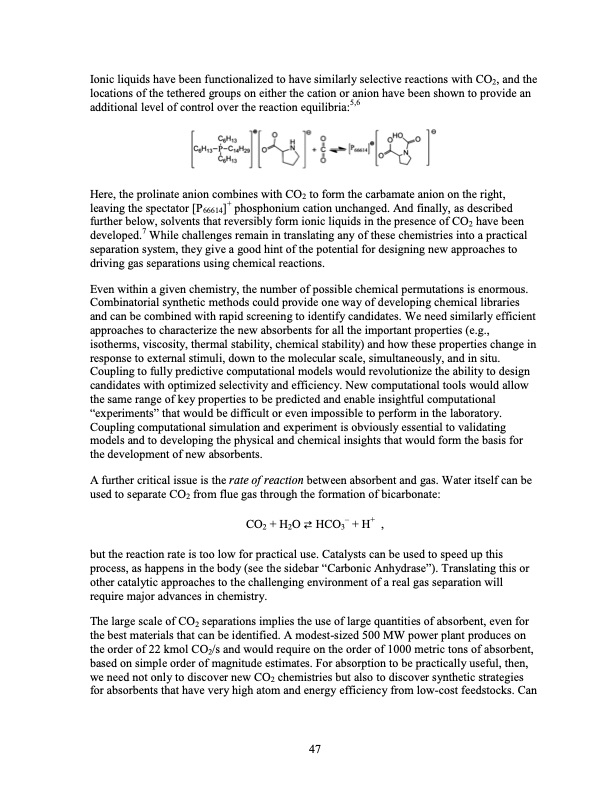
PDF Publication Title:
Text from PDF Page: 061
Ionic liquids have been functionalized to have similarly selective reactions with CO2, and the locations of the tethered groups on either the cation or anion have been shown to provide an additional level of control over the reaction equilibria:5,6 Here, the prolinate anion combines with CO2 to form the carbamate anion on the right, leaving the spectator [P66614]+ phosphonium cation unchanged. And finally, as described further below, solvents that reversibly form ionic liquids in the presence of CO2 have been developed.7 While challenges remain in translating any of these chemistries into a practical separation system, they give a good hint of the potential for designing new approaches to driving gas separations using chemical reactions. Even within a given chemistry, the number of possible chemical permutations is enormous. Combinatorial synthetic methods could provide one way of developing chemical libraries and can be combined with rapid screening to identify candidates. We need similarly efficient approaches to characterize the new absorbents for all the important properties (e.g., isotherms, viscosity, thermal stability, chemical stability) and how these properties change in response to external stimuli, down to the molecular scale, simultaneously, and in situ. Coupling to fully predictive computational models would revolutionize the ability to design candidates with optimized selectivity and efficiency. New computational tools would allow the same range of key properties to be predicted and enable insightful computational “experiments” that would be difficult or even impossible to perform in the laboratory. Coupling computational simulation and experiment is obviously essential to validating models and to developing the physical and chemical insights that would form the basis for the development of new absorbents. A further critical issue is the rate of reaction between absorbent and gas. Water itself can be used to separate CO2 from flue gas through the formation of bicarbonate: CO2 +H2O⇄HCO3– +H+ , but the reaction rate is too low for practical use. Catalysts can be used to speed up this process, as happens in the body (see the sidebar “Carbonic Anhydrase”). Translating this or other catalytic approaches to the challenging environment of a real gas separation will require major advances in chemistry. The large scale of CO2 separations implies the use of large quantities of absorbent, even for the best materials that can be identified. A modest-sized 500 MW power plant produces on the order of 22 kmol CO2/s and would require on the order of 1000 metric tons of absorbent, based on simple order of magnitude estimates. For absorption to be practically useful, then, we need not only to discover new CO2 chemistries but also to discover synthetic strategies for absorbents that have very high atom and energy efficiency from low-cost feedstocks. Can 47PDF Image | 2020 Carbon Capture

PDF Search Title:
2020 Carbon CaptureOriginal File Name Searched:
1291240.pdfDIY PDF Search: Google It | Yahoo | Bing
NFT (Non Fungible Token): Buy our tech, design, development or system NFT and become part of our tech NFT network... More Info
IT XR Project Redstone NFT Available for Sale: NFT for high tech turbine design with one part 3D printed counter-rotating energy turbine. Be part of the future with this NFT. Can be bought and sold but only one design NFT exists. Royalties go to the developer (Infinity) to keep enhancing design and applications... More Info
Infinity Turbine IT XR Project Redstone Design: NFT for sale... NFT for high tech turbine design with one part 3D printed counter-rotating energy turbine. Includes all rights to this turbine design, including license for Fluid Handling Block I and II for the turbine assembly and housing. The NFT includes the blueprints (cad/cam), revenue streams, and all future development of the IT XR Project Redstone... More Info
Infinity Turbine ROT Radial Outflow Turbine 24 Design and Worldwide Rights: NFT for sale... NFT for the ROT 24 energy turbine. Be part of the future with this NFT. This design can be bought and sold but only one design NFT exists. You may manufacture the unit, or get the revenues from its sale from Infinity Turbine. Royalties go to the developer (Infinity) to keep enhancing design and applications... More Info
Infinity Supercritical CO2 10 Liter Extractor Design and Worldwide Rights: The Infinity Supercritical 10L CO2 extractor is for botanical oil extraction, which is rich in terpenes and can produce shelf ready full spectrum oil. With over 5 years of development, this industry leader mature extractor machine has been sold since 2015 and is part of many profitable businesses. The process can also be used for electrowinning, e-waste recycling, and lithium battery recycling, gold mining electronic wastes, precious metals. CO2 can also be used in a reverse fuel cell with nafion to make a gas-to-liquids fuel, such as methanol, ethanol and butanol or ethylene. Supercritical CO2 has also been used for treating nafion to make it more effective catalyst. This NFT is for the purchase of worldwide rights which includes the design. More Info
NFT (Non Fungible Token): Buy our tech, design, development or system NFT and become part of our tech NFT network... More Info
Infinity Turbine Products: Special for this month, any plans are $10,000 for complete Cad/Cam blueprints. License is for one build. Try before you buy a production license. May pay by Bitcoin or other Crypto. Products Page... More Info
| CONTACT TEL: 608-238-6001 Email: greg@infinityturbine.com | RSS | AMP |